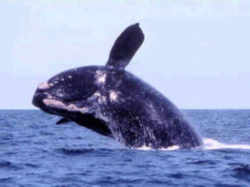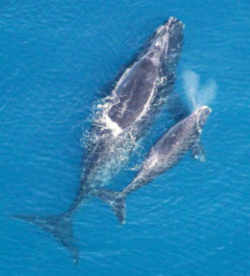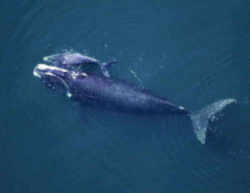
Massachusetts Symbols
Massachusetts State Marine Mammal
Right Whale

(Eubabalena glacialis)
Adopted in 1980.
The Right Whale, (Eubabalena Glacialis,) was adopted in March 1980. It was so called because the flourishing whaling industry in Massachusetts found the cetacean the "right" whale to hunt, especially before 1750. Unfortunately, the large, slow-moving mammal, which is found nearer shore than many other whales, was hunted nearly to extinction and is only now rebuilding its population.
Massachusetts State Marine Mammal: Right Whale

Right whales are three species of large baleen whales of the genus Eubalaena: the North Atlantic right whale (E. glacialis), the North Pacific right whale (E. japonica) and the southern right whale (E. australis). They are classified in the family Balaenidae with the bowhead whale. Right whales have rotund bodies with arching rostrums, V-shaped blowholes and dark gray or black skin. The most distinguishing feature of a right whale is the rough patches of skin on its head which appear white due to parasitism by whale lice. Right whales can grow up to 18 m (59 ft) long and weigh up to 100 short tons (91 t; 89 long tons), significantly larger than humpbacks or grays, but smaller than blues.
The Right Whale, (Eubabalena Glacialis,) is a large, blackish whale with the following features: no dorsal fin; head huge, about one-fourth of total length; baleen (whalebone) about 2 m long, 30 cm wide, and between 200 and 250 in number on each side of mouth; closure of mouth highly arched; no furrows on the throat; prominent, large, wartlike areas (called bonnets), the one near tip of snout largest. Total length of adults, 14-17 m; weight, 20-30 metric tons.
Right whales were so named by early whalers because they were the "right" whale to kill - they are slow swimmers and were thus easily caught, floated
when dead, and produced large quantities of oil and baleen. Consequently, right whales were decimated early by the world's whaling industries and have
yet to recover.
Right whales spend spring, summer, and autumn at high latitude feeding grounds and migrate to more southerly, warmer waters in winter for mating and
calving. Northern and southern populations do not interbreed due to asynchronous seasons between the hemispheres.
 Right whales produce a variety of vocal sounds
as well as percussive sounds of breaching, flipper slapping, and tail slapping. A distinctive clacking sound has been described for these whales as
they feed at the surface. Termed the "baleen rattle," this sound is produced by small wavelets rattling the baleen plates when they are partially held
out of water. Right whale sounds appear to differ with changing behavior and, thus, may be important in communication. As with other baleen whales,
right whales probably do not echolocate.
Right whales produce a variety of vocal sounds
as well as percussive sounds of breaching, flipper slapping, and tail slapping. A distinctive clacking sound has been described for these whales as
they feed at the surface. Termed the "baleen rattle," this sound is produced by small wavelets rattling the baleen plates when they are partially held
out of water. Right whale sounds appear to differ with changing behavior and, thus, may be important in communication. As with other baleen whales,
right whales probably do not echolocate.
Right whales feed by skimming through concentrations of krill. They have been seen feeding at depths ranging from the surface down to 10 m although
they may also feed at deeper levels. Location of krill concentrations in the water column probably determines feeding depth.
After a one-year gestation period, females give birth to a single calf in winter. Calves are 5-6 m in length at birth but grow rapidly during the subsequent
period of lactation, which lasts about 13 months. Calves remain with their mothers for 2-3 years following weaning and probably reach sexual maturity
at about 10 years of age. Females give birth at 2 to 7 year intervals.
Massachusetts Law
The law designating the right whale as the official Massachusetts state marine mammal is found in the General Laws of Massachusetts, Part 1, Title 1, Chapter 2, Section 16.
Massachusetts General Laws Annotated.
Part I. Administration of the Government.
Title I. Jurisdiction and Emblems of the Commonwealth, The General Court, Statutes and Public Documents.
Chapter 2. Arms, Great Seal and Other Emblems of the Commonwealth.
Section 16 Marine mammal or marine mammal emblem of commonwealth
Section 16. The right whale (Eubalaena Glacialis) shall be the marine mammal or marine mammal emblem of the commonwealth.
Taxonomic Hierarchy: Right Whale
Kingdom: Animalia
Phylum: Chordata
Class: Mammalia
Order: Cetartiodactyla[a]
(unranked): Cetacea
(unranked): Mysticeti
Family: Balaenidae
Genus: Eubalaena
Species: E. glacialis - (Muller, 1776)







